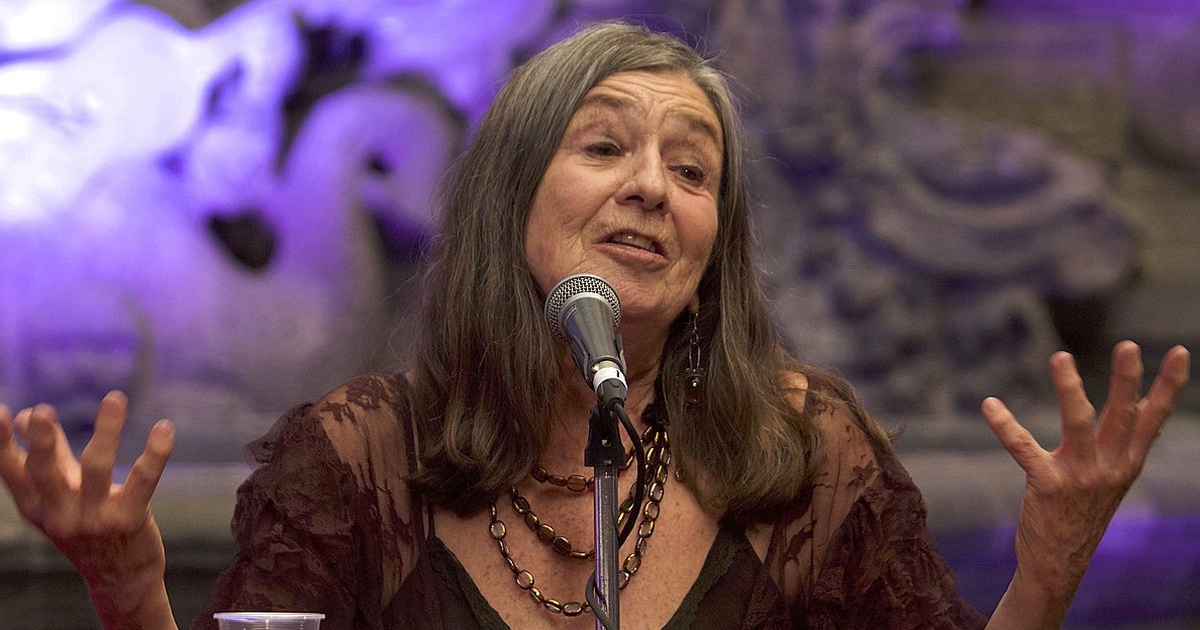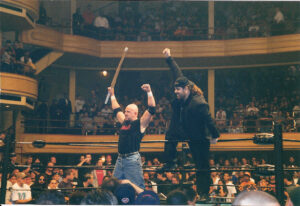Capturing wrestling in a still shot is difficult, to say the least. Its kinetic energy, theatrics, and performance all have spirits of their own, and breaking it down frame-by-frame is no small feat. The wrestling photographs shot by artist Lourdes Grobet strike viewers hard. The spaces Grobet moved through and translated in her photographs are tender and breathtaking. Lourdes Grobet was the first lady of lucha libre photography and developed relationships with stars of the sport like Blue Demon and El Santo, Irma Gonzalez, and Martha Villalobos. If you have not seen her photos, you should take part in her world.
Lourdes Grobet: Art, Lucha Libre, and Where the Two Meet
In the book that much of this information is sourced from, “Lucha Libre: Masked Superstars, of Mexican Wrestling Photographs by Lourdes Grobet” by Carlos Monsivais, the author writes about the artist,
“Much of Lourdes Grobet’s photographic work deals with transgression, humor, and provocation. Scoffing at the notion of preciousness, amid paradox she has always shown a fighter’s spirit. She sees through the eyes of those people whose voices generally fall on deaf ears. Going against trends and conventions, she does not seek to make images that suit the discourse which happens to be in vogue. Instead, those [images] she has made over the years add power to discourse that questions rather than uphold archetypes.”
Early Life
Born in Mexico City on July 25th, 1940, Lourdes Grobet’s family was Swiss and Mexican. Her father was a Mexican national bicycle champion which made sports a big part of her early life. In an interview, Grobet described growing up in the gymnasium her father owned, and that before she grasped hold of art in any formal way, her earliest subjects of fascination were the bodybuilders who frequented the place. Further, she paints her family’s interest in sports as intrinsic, like it was built into their hardwiring, a part of her mythology from her inception.
As Lourdes made her way through her childhood and adolescence in the 1950s, the boom of television was taking over much of the world. When her family decided to get a TV, one of the limited channels aired lucha libre every night and Lourdes became transfixed.
In the late 1800s leading into the 1930s, Mexican combat fighters created a new type of wrestling that was a mixture of the English-French catch-as-catch-can, Greco-Roman, and United States wrestling styles. Out of this, and other elements, lucha libre was born and attracted an explosive audience and fandom all around Mexico. As fans flocked to the squared circle, many famous luchadors’ began expanding into other areas of media like comic books, television, sports magazines, movies, and even more.
When she was little, with her burgeoning obsession, Lourdes repeatedly asked her father to take her to the arena to see the wrestlers live, but he flat-out refused and never gave in. She remembered him saying it was because she was his daughter, and he didn’t think those shows were appropriate for a young girl. Later in life, Lourdes said she carried that disappointment with her for years. It was when she picked up her camera for the first time, that she took herself to that very stadium. Lourdes describes one’s camera as a conduit that helps its director figure out her wants and needs, and her camera brought her to the wrestling ring.
Art Career Begins
Interested in art at an early age, Lourdes attended Mexico City’s Iberoamericana University where she studied painting. There, she met a professor who went on to inspire her for the rest of her life, Mathias Goeritz. He had a kind of anti-academic, decadent view of art and life, which allowed Lourdes boundless exploration in her art. One assignment he gave his students was to bring in a work of art that went beyond the limits of artistic tradition. While students came with still-life drawings and sketches, Lourdes and her partner showed up with a framed painting of a detonated atomic bomb. Goeritz was immediately moved by their originality.
Grobet’s first exhibitions played the senses, using installments featuring floodlights, mazes of murals, psychedelic lighting, and gastronomical pieces. But, while on a trip to Paris in 1968, Lourdes discovered how photography could capture a singular moment in time more accurately and quicker than other artistic mediums. It was then that Lourdes decided to completely dedicate herself to photography.
Returning to Mexico, Grobet brought her new medium into the space she loved; lucha libre. Now that she was an adult, she could finally attend the place that brought her such excitement as a child.
When Grobet began her journey in photography and brought her camera to wrestling arenas, she was met with a lot of pushback from men who had never seen a woman photographing wrestlers before. She reported that people felt angry at first, but when she explained her intentions, the promoters began catering to her and even gave her a special entrance.
Unlike the other photographers who worked the lucha libre events, Lourdes was not selling to sports magazines, so she was no competition to their work. And since Grobet had a less capitalistic approach to her art, there is a certain romance throughout her oeuvre that is dazzling. It was art for art’s sake.
In general, Lourdes described that lucha libre photographers, at the time, were looked down on by other sports photographers because of professional wrestling’s low-brow status. There is a class element that comes with loving wrestling, people from lower socioeconomic statuses tend to be attracted to the sport. This may come from wrestling’s circus roots, an event that families of all incomes could enjoy.
Lourdes Grobet and El Santo
The explosion of lucha libre can be attributed to many people, but especially to the luchador El Santo. He brought the sport into many spheres of entertainment like film, comic books, and more. El Santo was the stuff of legend, he was in almost fifty movies over twenty-five years, his career spanning over five decades. His prolific nature permeated Mexican culture in every way, making him more than just a wrestler. He was an icon.
When Lourdes began her squared circle photography, she befriended El Santo. She described him as incredibly generous to her and insisted that he was a very giving person to everyone. She would later say she had never seen someone so beloved by the people of Mexico. Lourdes used examples of the many times she would be working on a movie with El Santo in the middle of nowhere. They were low-budget productions, usually filmed in public streets or at friends’ houses. But Grobet said whenever they filmed outside and word traveled that El Santo was in town, fans flocked around him, and he would stay there until every single person got an autograph, and got to talk with him.
Grobet also promised she never saw his, or his longtime rival, Blue Demon’s faces. Other wrestlers she worked with, photographed, and developed relationships with removed their masks and revealed their visages. But when it came to El Santo and Blue Demon they maintained tradition and kayfabe, and she never saw them, nor did she want to. The illusion persisted until El Santo passed away in 1984.
Finding the People Behind the Masks
When Lourdes Grobet photographed wrestling matches, she expressed the importance of the fan-wrestler dynamic by capturing many photos of the audience. From the transfixed faces of three-year-old kids to the furrowed brows of 90-year-old grandmothers, Grobet conveyed how viewers can become spellbound by the power of wrestling.
Grobet had developed a relationship with, what was then known as, Empresa Mexicana de Lucha Libre (now known as Consejo Mundial de Lucha Libre), the first wrestling promotion in Mexico. Executives would allow Lourdes to maneuver her way around the perimeter of the ring during matches, capturing her photos without being seen.
But, when it came to luchadoras at the time, women’s wrestling was banned in the country’s capital. It was different throughout the 1920s and ‘30s however, when women in the country were able to become successful wrestlers. Their part in the sport demonstrated alternative choices for women, whose role was traditionally cemented in the gender binary. But as time went on, possibly in response to the economic, social, and personal independence women were garnering, Mexico City placed a ban on the sport in the ‘50s. The capital was where lucha soared in popularity, so the idea was that cutting the supply chain would force women’s wrestling into a slow, capitalistic death. That was not the case, as some people started promotions outside of the city.
So, to be able to see women wrestlers, Grobet had to travel to the State of Mexico. After meeting different luchadoras, she realized that many of them were working-class women, supporting their families in several different ways. Even with the luchadors she worked with, the majority weren’t as famous as Blue Demon or Santo, and Lourdes found that so many of them had to have second jobs to remain afloat. If they were wrestling every week, they could make a living, but so many people weren’t able to perform weekly.
This realization led Grobet to begin photographing luchadors and luchadoras at their second jobs as dental hygienists, police officers, teachers, and even a priest.
Then Grobet dove through another plane of their existence when she was invited into some of her subjects’ homes, where she took photos of them in their personal spaces. Showing that they are real people, with children, siblings, parents, and loved ones. Intersecting their personal lives and the lives of their wrestling personas showed a new understanding of these wrestlers as people. Taking photos of a villainous luchadora, holding and feeding her infant child, Lourdes was excitedly exploring these dichotomies.
She would come to refer to the women she met as “doubly heroic.” While they were talented in their own right, they were still barred from performing in the capital, where the large arenas and paychecks resided. Women’s wrestling would not be allowed in the city until the 1980s. Twice the heroism, the women she met had to support their families while trying to uphold their dreams that others rejected. Lourdes went on to photograph numerous luchadoras, La Briosa, Martha Villalobos, Panterita Surena, and Irma Gonzalez.
Read More: The Birth of Lucha Libre and 85 Years of CMLL
The Importance of Lucha Libre
Lucha libre is special, and different from other types of wrestling. Lourdes Grobet said she thought this is because it is so inextricably linked to Mexican culture, it can be felt when you watch it. This hypothesis was set in stone for Grobet when she invited a friend to attend a wrestling show with her. Afterward, he said he was, honestly, not a fan of what he had seen, but he wanted to return the favor and take her to a theatre of his choice. He brought her to the Campesino Theatre in the countryside of Tabasco. There, Lourdes met the cast made up of mostly Indigenous-Mexican actors and began a photographic series on the theatre company.
Grobet discovered that her work with wrestling “served as complimentary explorations into the characteristics of Mexican indigenous people…the naked or masked faces held clues to the collective identity that had migrated from the countryside to cities, still conserving its roots and its artistic inspiration.” From populous cities to the sprawling countryside, Grobet invested herself in discovering her country’s people.
Since Lourdes had amassed a great amount of experience with luchador cinema, in 2006, she had a chance to pass on her knowledge to others. Her part in the historic films led her to assist the producers of the movie, Nacho Libre, to capture the story of a luchador correctly. The inspiration from traditional luchador films can be felt throughout the movie.
Lourdes Grobet passed away in July of 2022, ten days before her 82nd birthday. What she left behind is an awe-inspiring oeuvre that celebrates Mexican culture and wrestling history. Her photos speak a language of their own, whispering to the spectator the secrets of the wrestlers behind the lens.
Header Image Credit: Milton Martínez / Secretaría de Cultura CDMX
Stay tuned to the Last Word on Pro Wrestling for more on this and other stories from around the world of wrestling, as they develop. You can always count on LWOPW to be on top of the major news in the wrestling world, as well as to provide you with analysis, previews, videos, interviews, and editorials on the wrestling world.






